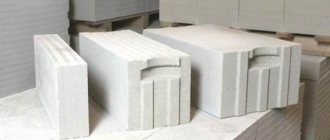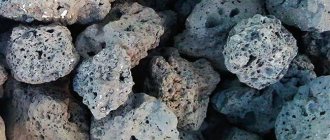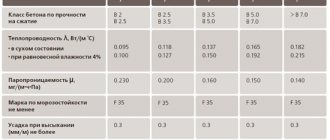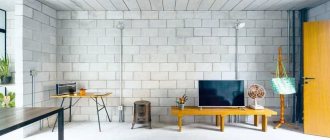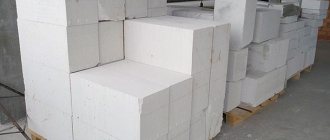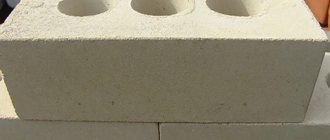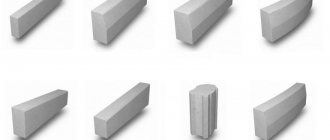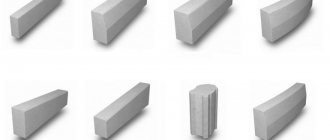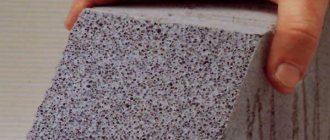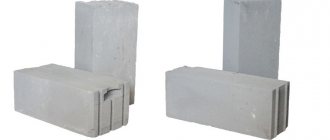Home |Types of concrete |What is foam concrete?
Date: December 22, 2018
Comments: 0
When performing construction work on the construction of private buildings and industrial facilities, cellular concrete, characterized by a porous structure, is widely used. Foam concrete, which is in demand among building materials, is obtained through the hardening process of a special composition with the addition of foaming components.
Manufactured by foaming, concrete composites are used for insulation and redevelopment of premises. The material is characterized by a set of positive characteristics that provide thermal insulation of rooms and comfortable temperature conditions.
Foam concrete successfully competes with traditionally used, non-interchangeable building materials, brick, reinforced concrete and wood, each of which has a number of individual advantages. Foamed composites combine a number of advantages and are characterized by increased strength characteristics, improved thermal and sound insulation, environmental friendliness, and ease of processing.
Let us consider in detail what foamed concrete is, where it is used, what it consists of, and how it is produced. Let's evaluate the positive aspects, disadvantages and criteria for choosing the material.
Foam concrete is a type of cellular concrete
Peculiarities
Foam concrete is characterized by a uniform distribution throughout the entire volume of an array of air pores, the size of which is up to 5 millimeters. The material refers to cellular concrete obtained by introducing a foaming agent into a previously prepared cement mortar.
The concentration of air cavities can be up to 80% of the total volume of the array. This contributes to a significant reduction in the mass of foam concrete products while maintaining strength characteristics and thermal insulation properties. The porous structure allows excess moisture to escape from the room, creating favorable humidity, making it difficult for mold to develop.
Externally, foam concrete material is easy to distinguish - it has a gray cement color. When immersed in water, the composite does not sink.
Methods for determining the quality of foam blocks
There are several ways to determine the quality of foam blocks visually, as they say “by eye”. Thus, the following quality parameters of foam blocks can be assessed:
- the homogeneity of the structure of foam blocks must be uniform throughout the entire mass of the block;
- air bubbles in the structure of the foam block should be small (no more than 1 mm);
- the shape of the air bubbles should be spherical;
- the air bubbles should be approximately the same, not interconnected;
- The color of the foam block should be gray, the color of cement, uniform throughout the entire block. If the foam block is light gray in color, it means that the proportions between cement and sand in the solution are not met;
- The foam block should not contain cracks. The presence of cracks indicates the existence of tension inside the block, as a consequence of the improper drying process of the block;
- there should be no streaks on the foam block or uneven color of the blocks;
- the foam block should not have traces of grease from iron molds;
- high-quality foam blocks do not sink in water;
- good foam blocks do not wobble if they are placed on top of each other;
- a high-quality foam block cannot be broken by hand;
- high-quality foam blocks have the same geometric dimensions.
Classification
Foam concrete, depending on the concentration of air cavities, has different areas of use and is divided into the following types:
- composites for thermal insulation purposes, marked with the Latin capital letter D and a digital index ranging from 150 to 400. These numerical values characterize the density of the massif, expressed in kilograms per cubic meter. The maximum strength class of the material is 0.75, which corresponds to a load of up to 9 kg/cm²;
Concrete is divided into CLASSES: VO.5, B2.5,..., B60, which are determined by the value of the guaranteed compressive strength
- compositions marked D500-D900, intended for structural and thermal insulation purposes. They are distinguished by increased specific weight of the composite up to 900 kg/cm³, increased strength from 16 to 35 kg/cm²;
- products for structural purposes, characterized by increased product density up to 1.2 t/m³ and the ability to withstand significant forces ranging from 50 to 90 kg/cm²;
- structural porous composites used for special purposes. This foam concrete is distinguished by increased density to 1.6 t/m³ and increased strength characteristics of the material.
The classification of foam concrete products is based on their specific gravity, which varies depending on the pore concentration.
Types of building stone
Foam concrete building products are produced in several modifications and standard sizes . They are grouped into classes based on the purpose and density of the structure, which is expressed by the number of empty cavities per unit volume. With a smaller number of pores, the density and strength of the product, its thermal conductivity and grade are greater. Foam concrete blocks are marked with the letter D from 100 to 1200.
Classification of foam blocks:
- Structural from D1000 to D1200, for load-bearing structures with the highest strength and weight indicators, 600x300x200 mm.
- Combined, structural and thermal insulation from D600 to D900 for private housing construction in the form of load-bearing structures with energy-efficient thermal protection, 600x400x200 or 300x200x600 mm
- Thermal insulation from D100 to D500, very light products, used for independent thermal insulation and sound protection systems, as well as for partitions, block size 100x300x600 mm.
Important ! The weight of foam blocks solely depends on the brand, however, under the influence of atmospheric conditions, it inevitably grows, which must be taken into account when designing the foundation.
Read more about the types of foam concrete blocks here.
Application
With an increase in the volume fraction of air cavities, the heat-protective properties and sound insulation characteristics of the foam mass increase, while the strength parameters of the products decrease. Therefore, foam concrete, which has a high density, is used for the construction of permanent walls of structures.
The most common compositions are those used for structural and thermal insulation purposes. They differ in their scope of application.
Foam concrete for structural purposes is used for construction:
- External walls of buildings that absorb forces from the mass of the building, roof.
Foam concrete is an ageless and almost eternal material that is not affected by time.
- The walls located inside the building, which are lightly loaded elements of the structure.
- Internal partitions dividing the space of a room that do not carry vertical loads.
Thermal insulating composites based on foamed concrete are used for thermal insulation and provide the ability to:
- insulate reinforced concrete floors;
- form a heat-insulating layer of wall structures;
- thermally insulate rooms under the roof;
- protect special technological equipment and pipelines, the temperature of which during operation increases to 500⁰С.
Composites for structural and thermal insulation purposes combine the ability to withstand significant loads and, at the same time, provide thermal protection of construction projects. Buildings based on foam concrete are characterized by increased thermal insulation characteristics and are superior to brick buildings in many respects.
Types and sizes of blocks
Foam blocks are divided into several types:
- Structural. Suitable for load-bearing walls. Brands: D1000, D1100 and D Standard foam block sizes are 200x300x600 or 200x400x600 mm.
- Structural and thermal insulation. A universal material suitable for thermal contours or walls. It is used for the construction of load-bearing structures or thermal insulation of existing buildings. There are four types: D600, D700, D800 and D. The dimensions of foam concrete blocks are 200x300x600, 200x200x400 or 100x300x600 mm. The thermal insulation properties of the wall depend on the width of the block.
- Thermal insulation. Blocks are used for thermal insulation of an object. They have low strength and are used for the construction of internal partitions. There are three grades based on density: D300, D400 and D. The size of the foam block is 400x200x600 mm.
Blocks have different masses, densities and sizes. Preliminary calculation will avoid many problems. The structural features of the structures and purpose are taken into account. Bricks are used according to standards. It is unacceptable to make load-bearing walls and a foundation for a house from low-density material.
What to build houses from
Various foam blocks are used for construction. Foam concrete and structures made from it are the ideal solution. Depends on the features and requirements for construction. When selecting material, it is worth considering the following recommendations:
- to raise external walls, blocks D900 are needed, but not lower than D600;
- foam blocks D100-300 are suitable for internal light partitions;
- blocks below D600 are widely used for heating circuits.
Any building can be quickly erected from foam concrete. When selecting material, technical characteristics and other factors are taken into account. This is especially true for the type of blocks and geometry. A good brick should have standard dimensions required by the standards. A slight deviation (2mm) is possible. Surface defects and cracks that reduce the strength of the material are not allowed.
The wall foam block that is used to build houses should look normal. This applies to the parameters and condition of the pallets. When buying foam blocks, they turn to the manufacturers.
A calculator is used to calculate the material. The calculation is simple: the number of cubes is calculated from the length, height and width.
Compound
Foam concrete is manufactured according to various recipes, the concentration of components in which varies depending on the required density of the mass. The production of foamed concrete is carried out using the following ingredients:
- Cement grade of at least M400, increasing which improves the quality of the composite.
To make foam concrete, mix a cement base with special additives
- River sand, the use of which guarantees a specific gravity of the foamed mass of 600 kg per cubic meter. It is allowed to use large expanded clay as a filler, which has a positive effect on increasing the strength characteristics of the massif.
- Water with a temperature of no more than 25 degrees Celsius. The mixture should contain 2.5 times less water than cement. This is the optimal proportion of the array.
- Foaming components, which are a concentrated foaming agent based on pine rosin, protein or bone glue. The composition can be used within no more than 20 days from the date of preparation.
Manufacturing technology
The production process of composites based on foamed concrete can be carried out using various methods:
- classic.
It involves introducing the resulting foam from a foam generator through special lines into the finished sand-cement mixture. The solution, mixed with foam in a mixer, forms a foam concrete mixture, after hardening which forms a foam concrete mass. This method has proven itself as a proven solution, the implementation of which requires a foam generator and an effective mixer;
The foamed mass falls into special molds, where it hardens in its natural environment
- polarization or, as experts call it, the method of dry mineralization.
The technology regulates the introduction of dry ingredients into a foamy stream supplied by a special device - a porosizer. Particles of the mixture settle on the surface of the foam bubbles, creating high-quality foam material that is transported along highways to the work area or special forms, where it hardens. The method is used for continuous pouring of the foam composition under the conditions of a facility under construction; - barotechnology.
It ensures the production of foamed concrete in pressure mixers at excess pressure without the use of foam generators. The process is carried out in special mixers operating under pressure, into which, after whipping high-quality foam, a cement-sand mixture is added. The resulting foam concrete mixture is supplied under pressure from the device to the working area to form a monolithic structure.
When choosing a particular production method, carefully analyze all economic aspects. Consider what the competitive advantages of the resulting foam concrete products will be.
Advantages of the material
Foam concrete has high performance characteristics, the main of which are:
- The ability of a material to retain heat indoors. The thermal insulation characteristics of foam concrete are 3 times higher compared to brick.
- The small mass of foam concrete products allows for prompt loading and unloading operations.
Foam concrete has a relatively high ability to absorb sound - The ability to erect building structures based on foamed concrete on a lightweight foundation, which ensures faster installation and reduces the duration of construction work.
- The strength of the products allows the use of foam concrete blocks for the construction of permanent walls of buildings with no more than three floors.
- Resistant to negative temperatures. Foam concrete withstands repeated cycles of freezing followed by thawing. At the same time, it maintains its integrity.
- Fire resistance, allowing the composite to withstand open fire and elevated temperatures for a long time without destruction or cracking.
- Environmentally friendly, based on the absence of release of substances harmful to health from the foam concrete monolith and the use of environmentally friendly natural raw materials - sand, water, cement.
- Possibility of manufacturing foam concrete blocks in the conditions of a specific construction site during the construction of monolithic buildings. You can also supply a prepared liquid composition through a special pipeline to fill it as a thermal insulation layer.
- Affordable price, contributing to a significant reduction in financial costs for the construction of foam concrete structures.
- Acceptable moisture resistance associated with the presence of sealed cavities that do not allow water to be absorbed into the thickness of the array.
- The long service life of the material retains its working properties regardless of the time of use.
- Ease of processing of foam concrete products, which can be easily drilled and sawed using conventional tools.
- Possibility of manufacturing on site. No need for special expensive equipment.
What is a foam concrete block?
Foam block is a porous building material made from a mixture of cement, water with sand and a foaming agent. This is one of the varieties of cellular concrete (foam concrete). But unlike aerated concrete, which is similar in structure, voids in it are formed not due to chemical reactions inside the block during the hardening process, but due to the mixing of the concrete mixture with pre-prepared foam.
The foaming agent used is organic or synthetic. The first protein-based option is more expensive, but the block with it is more durable and environmentally friendly. Synthetics are cheap, but have a 4th hazard class. The foam blocks themselves are safe, but you have to be more careful when mixing the solution when working with the original mixture.
Forms for pouring foam concrete mixture
This material for building houses is produced in two ways:
- By cutting a monolith of hardened foam concrete into “bricks” of the required size;
- Filling forms with the required dimensions in width, height and length.
The process of sawing an array of hardened foam concrete into blocks
To save on raw materials and increase the density of the blocks, ash, clay and other bulk fine-grained materials are often added to the mixture when mixing. On the one hand, this allows a significant reduction in cement consumption, and on the other hand, it leads to thickening of the interpore walls inside the foam block, making the product more durable. Moreover, the size of internal voids in this case decreases, increasing the thermal conductivity of the material.
Appearance
Weak sides
Along with the positive aspects, foam composite blocks have some disadvantages:
- increased shrinkage of up to 3 millimeters per meter of constructed main wall. The factor is associated with an increased concentration of moisture caused by a violation of manufacturing technology or storage of products in the open air (under the influence of precipitation);
- the need for special finishing of the facades of buildings made of foam concrete in order to prevent moisture absorption;
- reduced mechanical strength, which is the cause of chips that occur on the edges. The foam composite requires careful handling during loading, unloading and carrying;
- the need to use special fastening elements for foam concrete, since the walls do not hold standard fastening elements - dowels, nails, screws.
What you need to know and do before purchasing a batch of foam blocks
Before you begin choosing foam blocks for building a house, you must perform the following steps:
- study the requirements of GOST 21520-89 “Cellular concrete wall blocks, small. Technical conditions.”;
- find an organization that produces foam blocks in accordance with the requirements of this GOST;
- find out what documents confirming the quality of foam blocks are attached to each batch of manufactured blocks;
- see what technology is used to produce foam blocks at this enterprise (by injection molding into a multi-place iron mold or by cutting foam blocks from a common mass of foam concrete);
- find out if the company has its own testing laboratory;
- ask the opinion of the clients of this enterprise regarding the quality of the blocks.
All this is not at all difficult to do.
After reading this article and completing all the steps indicated in it, the reader will speak the same language with representatives of the foam block manufacturer.
Read on the same topic - “Making building interlocking blocks from foam concrete - video”
Read on the same topic - “Making tongue-and-groove wall slabs from foam concrete - video”
Material selection
By carefully approaching the issue of choosing a foam composite, you can save money, avoid mistakes, and have a positive impact on the service life of the building. When purchasing foam concrete, pay attention to the following factors:
- Manufacturer, availability of quality certificates, compliance of foam concrete products with the requirements of regulatory documents.
The information openly provided by the manufacturer indicates compliance with the manufacturing technology and the absence, in the future, of unforeseen situations. GOST standards for the production of foam concrete are the same - The cost of products, a significant understatement of which indicates an attempt to sell low-quality products under the brand of high-quality structural material.
- The color of foam concrete blocks, which should have a grayish tint of uniform color.
- A structure characterized by the homogeneity of the arrangement of cavities of a regular spherical shape inside the array and on its outside.
- No cracks or chips in air pores.
- Compliance with the geometric dimensions of the blocks, the shape of which must correspond to a regular rectangular parallelepiped. You can evaluate the geometry of the array by comparing the sizes of several foam blocks.
- The date of manufacture of the foam material, which can be used in construction 4 weeks after the end of production.
The given recommendations will allow you to purchase a high-quality foam composite and avoid unforeseen situations. Be sure to properly protect products from moisture by using polyethylene, or store products indoors.
